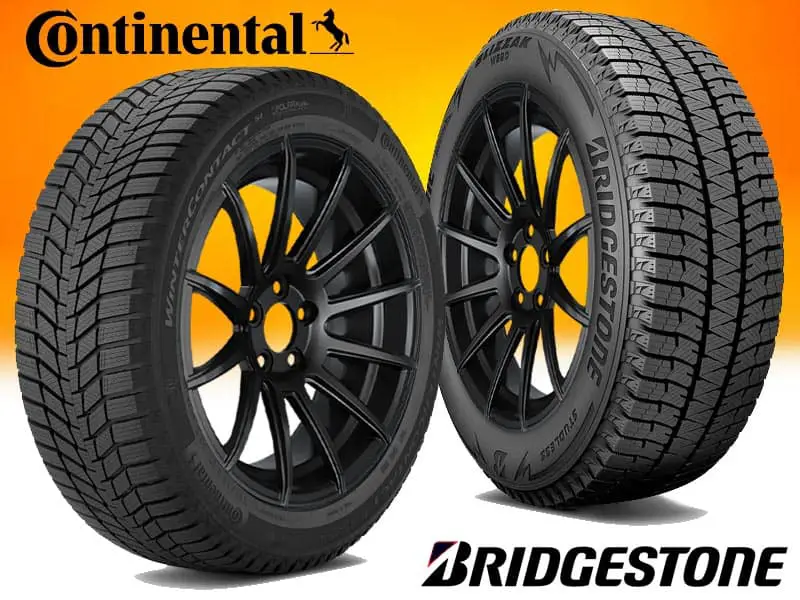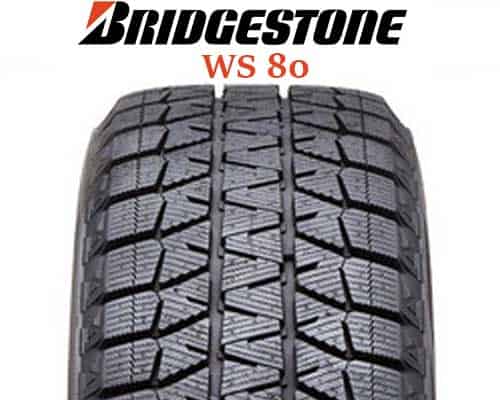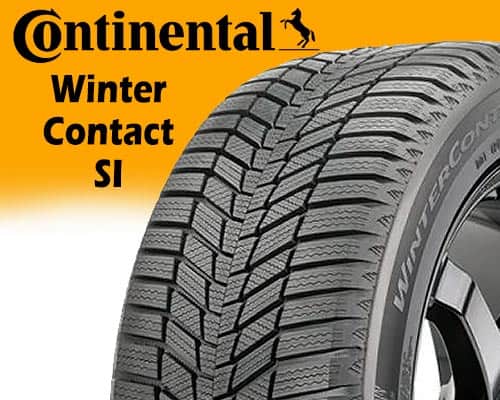Let’s dive deeper into the comparison between the Bridgestone Blizzak WS80 and the Continental WinterContact SI winter tires, exploring their unique features and differences.
Table of Contents
Brand Comparison
Both Bridgestone and Continental have a long-standing presence in the tire industry and are recognized for their commitment to producing high-quality tires.

Bridgestone:
- Established and reputable tire manufacturer.
- Known for innovation and quality.
- Offers a wide range of tire options for various driving needs.
- Bridgestone Blizzak series is renowned for winter tire performance.
Continental:
- A well-respected global tire manufacturer.
- Emphasizes cutting-edge tire technology.
- Offers a diverse selection of tires for different vehicle types.
- Known for its focus on performance and safety.
Bridgestone Blizzak WS80

The Blizzak WS80 has earned its reputation for delivering outstanding performance in extreme winter conditions. Its distinctive multi-tread cell design is a standout feature, allowing drivers to maintain control even in the harshest winter environments.
The WS80 is equipped with a multitude of deep sipes that greatly enhance its grip on wet roads. Thanks to its high void ratio, it excels in soft snow terrain, with wide grooves that efficiently expel snow, allowing the tire to move forward.
The high void ratio also results in a smaller contact patch, reducing rolling resistance, which in turn improves fuel efficiency and extends treadwear. Additionally, Bridgestone offers a 5-year warranty on these tires, although there is no mileage warranty.
Continental WinterContact SI
Continental’s WinterContact SI is another winter tire designed to perform exceptionally in challenging weather conditions. These tires feature narrower grooves compared to their competitors, resulting in a larger contact patch.

This translates to superior performance on dry and icy roads. The WinterContact SI handles dry and wet conditions admirably, thanks to its closely packed shoulder lugs that increase the tire’s biting edge.
The tire’s hydroplaning resistance is commendable, thanks to circumferential grooves and deep sipes that efficiently evacuate water from the tread. However, it’s important to note that the WinterContact SI’s wet braking distance is slightly longer than that of the Blizzak WS80.
Continental offers a 6-year tread warranty, along with a free replacement for the first year or 2/32 of wear, and a 60-day trial period with a free 3-year flat change.
Grip Comparison
When it comes to grip, the Blizzak WS80 performs admirably in wet conditions, thanks to its deep sipes. It offers strong traction on wet roads, making it a reliable choice for rainy conditions.
However, it falls slightly short on dry roads due to its higher void ratio, which reduces the contact patch. The WS80’s grip on ice is not as effective as the WinterContact SI, primarily due to its lower contact patch.
The WinterContact SI excels in dry and icy conditions, boasting a superior grip thanks to its narrow grooves and closely packed shoulder lugs.
On dry roads, the SI provides remarkable handling due to its increased biting edge. However, its wet grip is slightly compromised, with a longer braking distance than the WS80. The WinterContact SI’s grip on soft snow is not as efficient as its counterpart.
Handling Comparison
On dry roads, the Blizzak WS80 faces challenges due to the position of its shoulder blocks, which reduces the contact patch. This can affect traction when driving on dry surfaces.
The situation is similar on wet and icy roads, where the WS80 struggles slightly. However, its deep and frequent sipes contribute to improved traction on wet roads.
In comparison, the WinterContact SI delivers remarkable dry handling, thanks to its closely packed shoulder lugs, resulting in increased biting edges and premium handling.
The higher contact patch and power sipes enhance block rigidity, providing excellent handling on wet and icy terrains.
Hydroplaning Resistance
Both tires offer excellent hydroplaning resistance due to their unique tread designs. The Blizzak WS80’s wide grooves, deep sipes, and efficient central rib design effectively evacuate water, making it highly resistant to hydroplaning.
The WinterContact SI, with its wide lateral circumferential grooves and deep sipes, also promotes quick water evacuation, enhancing hydroplaning resistance.
Rolling Resistance
Rolling resistance measures the energy required to keep a tire rolling on a surface.
The Blizzak WS80, with its high void ratio and advanced technologies, such as notch and variable thickness sipes and multicell technology, offers reduced rolling resistance compared to the WinterContact SI.
This lower rolling resistance makes it more fuel-efficient.
Conversely, the WinterContact SI’s low void ratio results in a higher contact patch, leading to increased rolling resistance. This means the tire requires more energy to roll on the road, which can impact fuel efficiency.
Durability and Treadwear
Based on tread design and rolling resistance, the Blizzak WS80 is expected to have slower treadwear than the WinterContact SI. Bridgestone offers a 5-year warranty, starting from the tire’s manufacturing date, without a mileage warranty. Replacement for unusable tires is available at a pro-rated retail price.
In contrast, the WinterContact SI’s higher rolling resistance may lead to faster treadwear.
Continental offers a 6-year tread warranty, along with a free replacement for the first year or 2/32 of wear. Customers also benefit from a 60-day trial period and a free 3-year flat change.
Price
The price difference between the two tires is minimal. The Blizzak WS80 tends to be on the higher end due to its grip on wet roads, improved traction on soft snow, lower rolling resistance, and robust build quality.
On the other hand, the WinterContact SI offers excellent handling on dry and wet roads, increased hydroplaning resistance, and superior grip on dry and icy terrains at a slightly lower price. Ultimately, your choice should align with your specific needs.
Summary
In summary, both the Bridgestone Blizzak WS80 and the Continental WinterContact SI are winter tires, each with its own strengths and weaknesses. The WS80 excels in wet conditions, soft snow, and offers lower rolling resistance for improved fuel efficiency.
The WinterContact SI shines on dry and icy roads, provides excellent hydroplaning resistance, and offers a slightly lower price point. Your decision should be based on the specific weather conditions you encounter and your priorities, whether it’s wet grip, dry handling, or fuel efficiency.